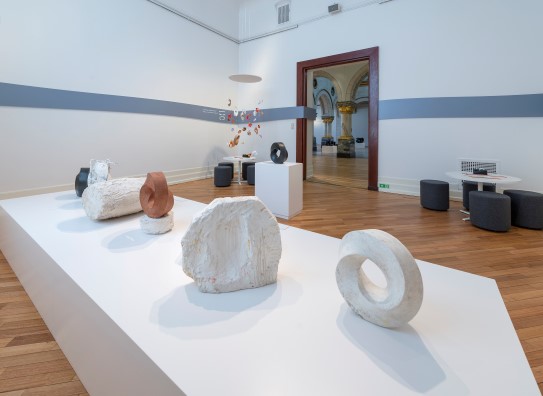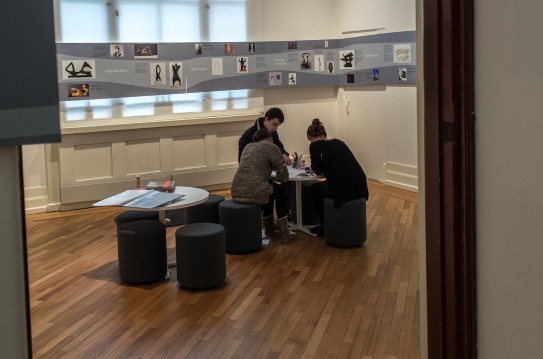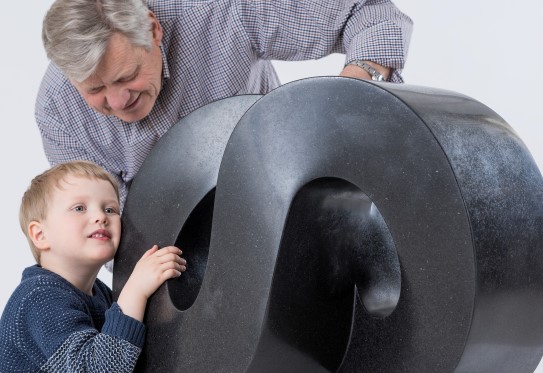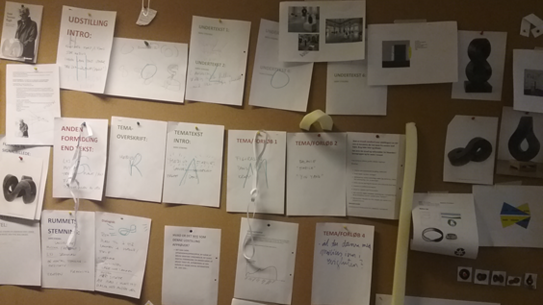In the research article "Interactive sensory approach to modernist sculpture: from education practice to exhibition concept", curator education at the National Museum, Line Engen, examines two exhibition- and education projects.

A participatory exhibition space
The exhibition "Aase Texmon Rygh. Modernism for ever!" at The National Museum in 2014, presented a range of Aase Texmon Rygh’s modernist sculptures. It featured three rooms which were used for educational purposes. Here, visitors could participate in activities such as: touching a bronze sculpture, watching a casting process, and making paper sculptures. The museum thus offered an active participatory learning experience, which took place inside of the exhibition space and which was open to everyone, as part of the exhibition's educational program.
Engen’s article describes how these educational spaces were founded on various theoretical perspectives, experience in education, and knowledge relating to audiences. With regard to this, she refers to research about participation in museums and theories concerning an active approach to art. According to Engen, mediators observe great appreciation among both children and adults for open workshops, in which they can take part in activities and art-based creative processes.
A need for increased knowledge about contemporary art
In connection to the mediation of the exhibition "Aase Texmon Rygh. Modernism for ever!", the National Museum took a number of important considerations into account. Engen’s article discusses both her own experiences and visitor surveys, which show an overall need for increased knowledge about contemporary art. Reference is also made to research which reveals that schoolchildren seldom encounter topics related to art created after 1945 at school, which might be one of the reasons why contemporary art may not play a central role in the common imagination of the public. Engen claims that this lack of basic knowledge on this topic, can be of hindrance to an emotionally powerful experience in encountering a work of art. Studies also indicate that many people find the experience of contemporary art to be alienating. In the Texmon Rygh-exhibition, one of the means of taking this into account, was by displaying a timeline consisting of text and images, providing educational insight into the artist and modernism – in a pedagogical way.

A trend-setting exhibition concept
Following the Texmon Rygh-exhibition, the use of educational rooms at the National Museum became more extensive. The meditation rooms and the concept of the exhibition also formed the point of departure for the touring exhibition «Aase Texmon Rygh. The Form of Eternity», where for the first time, the public had the opportunity to touch modernist sculptures which were on display.

The power of touch
The article presents results from observations of- and interviews with the audience. The exhibition encouraged a concept of "first sensing, then comprehending", but according to the audience surveys, most people wished to read the wall texts or to make something first, and then to touch the objects. Engen claims that this demonstrates how important it is to offer alternative approaches to the different themes and objects on display. In the early nineties, the American research duo Lynn Dierking and John Falck asserted the importance of putting emphasis on the individual museum experience, in context of the personal, the social, and the physical.
In the visitor surveys referred to above, some individuals responded that the experience of touching the sculptures contributed to an increased awareness of the objects. Others responded that they wished “...to touch the materials of cool and cold stone. Liking the calmness in them.” Engen links these findings to the concept of affective touch in cognitive and neurological research. She points out that when people touch things, they do so not only to examine them, but also to get a feel of the object – which transmits signals to the emotional areas of the brain. Engen also claims that objects, by means of touch, may enter someones personal space. Such an intimate meeting with an artwork, contributes to it no longer being "a stranger", Engen argues.
A toolkit for innovation
The article emphasizes the importance of collaboration and interdisciplinary creative project work in facilitating innovation. In the projects investigated, the "Toolkit" was used – a method which ensures that all parties in a project are involved at an early stage of the process, and that the visitors’ perspective is included from the very beginning. This idea-phase is limited in time but open in form, making it possible for everyone involved to contribute their opinions and ideas.

References
Engen, L. (2021). Interaktiv sanselig tilnærming til modernistisk skulptur: fra formidlingsstrategi til utstillingskonsept. Norsk museumstidsskrift, 7(1), 23–42. https://doi.org/10.18261/issn.2464-2525-2021-01-03
Engen, L. (2021). Practice-led Research in the Art Museum: Research on Education Practices Led by the Practitioners. Nordic Journal of Art and Research, 10(2). https://doi.org/10.7577/information.3769
Falk, J. H. og Dierking, L. D. (1992). The Museum Experience. Whalesback Books.
Pringle, E. (2019). Rethinking Research in the Art Museum. Routledge.
Uldall, A. G. (2016). Verktøykassa: det kreative arbeidet med utstillinger i Nasjonalmuseet. Nasjonalmuseet.